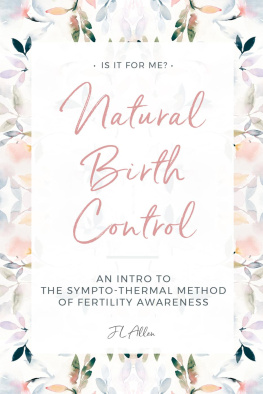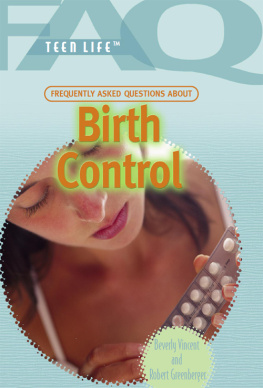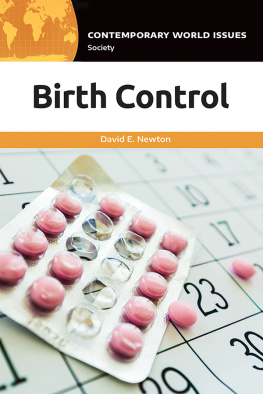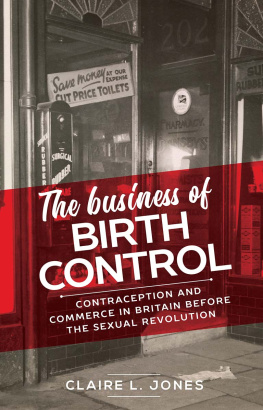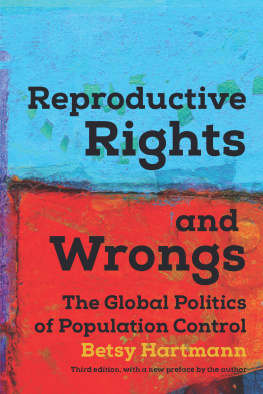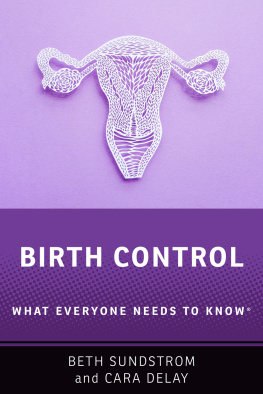Birth Control
Aharon W. Zorea

Copyright 2012 by Aharon W. Zorea
All rights reserved. No part of this publication may be reproduced, stored in a retrieval system, or transmitted, in any form or by any means, electronic, mechanical, photocopying, recording, or otherwise, except for the inclusion of brief quotations in a review, without prior permission in writing from the publisher.
Library of Congress Cataloging-in-Publication Data
Zorea, Aharon W.
Birth control / Aharon W. Zorea.
p. cm. (Health and medical issues today)
Includes bibliographical references and index.
ISBN 9780313362545 (hard copy : alk. paper) ISBN 9780313362552 (ebook)
1. Birth controlUnited States. 2. Birth controlGovernment policyUnited States. I. Title.
HQ766.5.U5Z67 2012
363.960973dc23 2011043157
ISBN: 9780313362545
EISBN: 9780313362552
16 15 14 13 12 1 2 3 4 5
This book is also available on the World Wide Web as an eBook.
Visit www.abc-clio.com for details.
Greenwood
An Imprint of ABC-CLIO, LLC
ABC-CLIO, LLC
130 Cremona Drive, P.O. Box 1911
Santa Barbara, California 93116-1911
This book is printed on acid-free paper 
Manufactured in the United States of America
Recent Titles in Health and Medical Issues Today
Alternative Medicine
Christine A. Larson
Gene Therapy
Evelyn B. Kelly
Sports Medicine
Jennifer L. Minigh
Nutrition
Sharon Zoumbaris
HIV/AIDS
Kathy S. Stolley and John E. Glass
Medical Imaging
Harry LeVine III
Medicare
Jennie Jacobs Kronenfeld
Illicit Drugs
Richard E. Isralowitz and Peter L. Myers
Animal-Assisted Therapy
Donald Altschiller
Alcohol
Peter L. Myers and Richard E. Isralowitz
Geriatrics
Carol Leth Stone
Plastic Surgery
Lana Thompson
Contents
Series Foreword
Every day, the public is bombarded with information on developments in medicine and health care. Whether it is on the latest techniques in treatment or research or on concerns over public health threats, this information directly affects the lives of people more than almost any other issue. Although there are many sources for understanding these topicsfrom websites and blogs to newspapers and magazinesstudents and ordinary citizens often need one resource that makes sense of the complex health and medical issues affecting their daily lives.
The Health and Medical Issues Today series provides just such a one-stop resource for obtaining a solid overview of the most controversial areas of health care in the twenty-first century. Each volume addresses one topic and provides a balanced summary of what is known. These volumes provide an excellent first step for students and laypeople interested in understanding how health care works in our society today.
Each volume is broken into several sections to provide readers and researchers with easy access to the information they need:
provides overview chapters on background informationincluding chapters on such areas as the historical, scientific, medical, social, and legal issues involvedthat a citizen needs to intelligently understand the topic.
provides capsule examinations of the most heated contemporary issues and debates and analyzes in a balanced manner the viewpoints held by various advocates in the debates.
and a directory of organizations that serve as the best next step in learning about the topic at hand.
The Health and Medical Issues Today series strives to provide readers with all the information needed to begin making sense of some of the most important debates going on in the world today. The series includes volumes on such topics as stem-cell research, obesity, gene therapy, alternative medicine, organ transplantation, mental health, and more.
Introduction
Artificial forms of birth control are now a common part of modern American life. As of 2010, the National Center for Health Statistics reported that 99 percent of sexually experienced women aged 15 to 44 have used some form of contraceptive at least once in their lives. Without the benefit of historical context, this simple statistic might suggest that birth control is now universally accepted and free from controversy. But a little more than a half century ago, when the first oral contraceptive was introduced, there were at least three states that outlawed the public sale and distribution of birth control. Just over a century ago, every church opposed birth control, every state had some prohibition against its dissemination as a form of obscenity, and certain sectors of the federal government actively monitored violations. The fact that birth control is now so common reflects a history of dramatic moral, social, political, and economic changes over the course of the twentieth century.
Even today, the predominance of birth control does not accurately reflect the level of controversy that is still associated with it. It is true that almost all women have used some form of birth control, but there are differences among methods and practice among sexually active women, suggesting greater diversity of opinion. At least 20 percent of sexually active women choose to permanently eliminate any chance of conception by sterilizing themselves or their partners. A majority of sexually active women (about 56 percent) remain open to conception in the future but choose one or more contraceptive methods. A large minority of sexually active women (about 20 percent) choose not to use any contraceptives at all. Although statistics provide little insight into personal motivation, the distribution of these results suggests a lack of consensus among American men and women on the role of contraceptives in their lives. Despite the nearly universal experimentation, birth control remains controversial for a variety of moral, political, and economic reasons.
Historically, the practice and promotion of birth control has never been without some level of controversy. Contraceptives are not new, and references can be traced back to ancient times, with the earliest description of pessaries in Egypt dating from around 1850 BCE. Similar accounts found in ancient Roman, Indian and Chinese texts suggest that the practice was not limited to any single culture or era, but their scarcity also indicates that the dissemination of birth control information was usually limited or deliberately kept away from the mainstream of social discussion.
In more recent times, especially in the United States, birth control was regarded as immoral and unsafe. By modern standards, many methods used prior to the 1800s were unreliable and unsanitary. Such remedies included ritualistic charms, mercury-based potions, herbal mixtures, and pessaries made from any number of substances ranging from acacia gum to crocodile dung. Some of the social prohibitions against contraceptives certainly arose from twin concerns about consumer fraud and public safety. Doctors warned patients of the dangers of magical cures and their snake-oil salesmen, while the legal system prosecuted the purveyors of contraceptive manuals and devices under decency laws as an offense against the public order.
Yet even beyond the obvious risks to health and pocketbook, popular culture in the nineteenth century generally disapproved of artificial birth control as an offense against nature. The religious community viewed conception as a miracle that was only partially the result of human sexuality. The political community viewed population growth and its related increase in human labor as a key to national prosperity. For most Americans in the early 1800s, the idea of limiting family size seemed both selfish and a little unpatriotic. In this environment, birth control had very few advocates.


